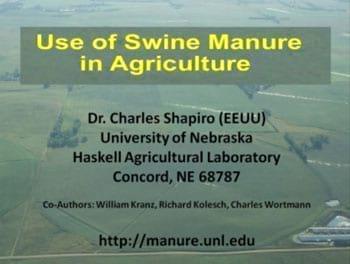Kinetics of thermochemical conversion of liquid manure
Published: October 22, 2008
Source : University of Illinois Extension
Summary
In the first stage research, a batch thermochemical (TCC) reactor was developed and a systematic investigation of process parameters conducted. TCC process parameters include operating temperature, type and initial pressure of process gases, retention time, total solids content, and pH level of feedstock. The process was evaluated in terms of oil-production efficiency and waste-reduction efficiency. The oil product was analyzed for its benzene solubility, elemental composition, and heating values. Necessary retention time to achieve an oil product largely depended on operating temperature. At 295°C to 305°C, retention time was 15 to 30 min. Based on an average of 135 different treatments, 62% of volatile solids (or 54% of total solids) was converted to oil product. Waste strength was reduced by 60 to 70%. Highest oil-production efficiency was 80% of volatile solids (or 70% of total solids). Average carbon and hydrogen contents were as high as 72% and 9%, respectively. Heating values for 80% of oil products ranged from 32,000 to 36,700 kJ/kg. Average conversion rate of volatile solids to oil can be as high as 70%. Based on this, the lifetime manure from one finishing pig can yield 20 gal crude oil, or a farm producing 10,000 market hogs per year can produce 4,760 barrels of crude oil per year. Based on a crude oil price of $30/barrel, oil production from manure could amount to $15/pig value added. We have also further processed TCC crude oil and obtained refined oil. TCC oil may also be used for alternative applications such as making plastics and inks.
Based on results of the batch reactor study, we have a much better understanding of key variables involved in the TCC process. A continuous TCC process appears more practical.
A draft of the design for a semi-continuous thermochemical conversion reaction system (CTCC) has been developed. Before being pumped into the high-pressure reactor, feedstock will have to be processed into a homogeneous slurry using a high-performance processor so as to prevent pressure leakage across the slurry check valves. The high-pressure feeder can be either a diaphragm or a plunger pump. The high-pressure reactor will be the batch type reactor used in the first stage research, but with some modifications. Ancillary parts include control modules, feed inlet and liquid products outlet, gas products outlet that runs through a reflux condenser, and mass flow controllers. The liquid products will be withdrawn to a pressure vessel equipped with a cooling jacket to lower liquid products temperature and simultaneously reduce pressure. Gas products will be collected in a gas cylinder. Reflux condensers are added to prevent condensable gases from escaping the reactor.
Swine manure will have to be pre-processed (by gravitational settling and grinding) to the desirable solids content and consistency, before being fed to the CTCC feed hopper. Based on the preliminary study using the batch reactor, the following operating conditions are recommended for use in the continuous TCC processor.
* Operating temperature 295 to 305C
* Operating pressure 90 to 110 bar
* Retention time 15 to 30 min
* Total solids content of feedstock (by weight) 20 to 25%
* Feedstock pH not controlled
The following factors and analytical parameters are recommended for evaluation of technical feasibility, economical viability, and environmental soundness of the proposed continuous TCC process.
* Oil production efficiency of process
* Elemental or chemical composition of process products
* Energy content of oil product
* Physical properties of oil product, including thermal heat loss and viscosity
* COD reduction rate of feedstock
Conclusion
It is now practically possible to produce useful oil and a char-like substance from pig manure.
By Yuanhui Zhang, Ph.D., P.E.
Professor and Associate Department Head
University of Illinois Extension
Swine Odor and Waste Management Papers
Source
University of Illinois ExtensionRelated topics:
Recommend
Comment
Share

Would you like to discuss another topic? Create a new post to engage with experts in the community.





